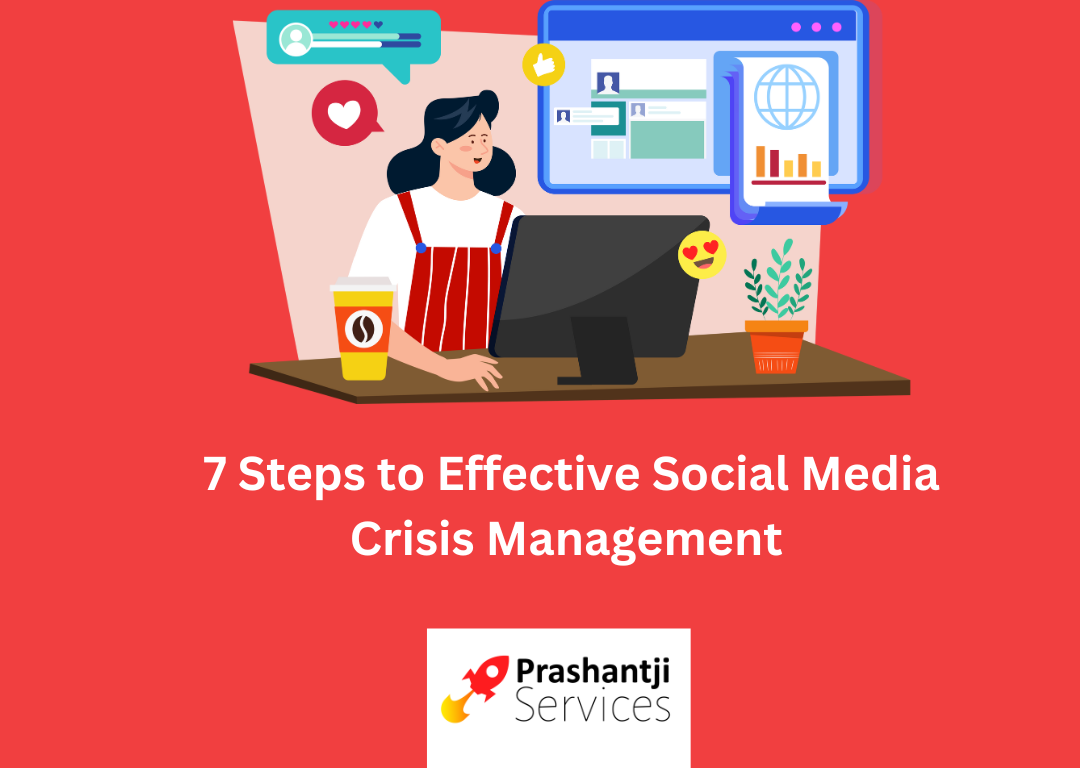Social media has become an integral part of modern brand management, offering unparalleled opportunities to engage with audiences and build a positive reputation. However, the same platforms that connect brands with their followers also carry the risk of unexpected challenges. Managing a social media crisis is one of the most critical tasks a business can face. How a brand navigates these turbulent times can significantly influence its public perception, either preserving its reputation or leading to long-term damage. This blog outlines 7 essential steps for managing social media crises effectively, ensuring your brand remains resilient in the face of adversity.
7 Steps to Effective Social Media Crisis Management

1. Prepare in Advance
The first step to managing any social media crisis is preparation. Don’t wait for a crisis to strike before you start thinking about how to manage it. Create a social media crisis management strategy which will highlight the steps to take in the event of a crisis or crises. This plan should include clear guidelines on who will be involved, what roles they will play, and how you will communicate with your audience. Having a plan in place will ensure that your team can respond quickly and effectively when a crisis arises.
Primary Actions:
- Identify potential crises: Think about the types of social crisis your brand could face and plan how to respond.
- Establish a crisis team: Assign roles and responsibilities to team members.
- Create a communication strategy: Plan how you will communicate with your audience during a social media crisis.
2. Monitor Social Media Channels
Constantly monitoring your social media channels is essential for early detection of potential crises. Utilize social monitoring tools to keep an eye on brand mentions, keywords releated to your industry, and any unfavorable feedback. By identifying issues early, you can address them before they escalate into a full-blown social media crisis.
Primary Actions:
- Set up alerts for keywords related to your brand and industry.
- Monitor conversations across all social media platforms.
- Identify patterns that may indicate the start of a social crisis.
3. Respond Quickly and Appropriately
Timing is critical in social media crisis management. When a social media crisis hits, acknowledge the issue quickly, even if you don’t have all the answers yet. Your audience needs to know that you are aware of the situation and are working to resolve it.
Primary Actions:
- Acknowledge the crisis: Post a statement that shows you are aware of the issue.
- Provide regular updates: Keep your audience informed as the situation evolves.
- Apologize if necessary: A sincere apology can go a long way in diffusing tension.
4. Communicate Transparently
During a social crisis, transparency is key. Be open and honest about what has happened, what you are doing to resolve the situation, and what your audience can expect next. Avoid vague statements or deflecting blame. Transparency helps build trust and can prevent further damage to your brand’s reputation.
Primary Actions:
- Be honest about the situation, even if the news is bad.
- Share your plan for addressing the crisis.
- Interact with your audience: Address comments and messages promptly.
5. Manage the Narrative
In a social media crisis, it’s important to control the narrative as much as possible. Don’t let misinformation or negative sentiment take over. Use your social media platforms to share accurate information and your perspective on the situation. This can help shape public perception and prevent the crisis from spiraling out of control.
Primary Actions:
- Issue official statements through your social media channels.
- Correct misinformation: Address any false claims or rumors circulating online.
- Highlight positive actions you are taking to resolve the crisis.
6. Learn from the Crisis
Once the immediate crisis has been handled, it’s important to analyze what happened and learn from it. Conduct a post-crisis evaluation to identify what went wrong, what you did well, and how you can improve in the future. This step is crucial for refining your social media crisis management strategy and preventing future crises.
Primary Actions:
- Analyze data from the crisis: What were the triggers? How did your audience react?
- Update your crisis plan based on what you’ve learned.
7. Rebuild and Restore Trust
After a social media crisis, it’s essential to rebuild trust with your audience. This might involve addressing lingering concerns, launching a positive PR campaign, or taking steps to improve your product or service. The goal is to show your audience that you’ve learned from the crisis and are committed to moving forward in a positive way.
Primary Actions:
- Follow up with your audience: Share how you’ve addressed the issue and what changes have been made.
- Launch a positive campaign: Focus on rebuilding your brand’s image and trust.
- Continue to engage with your audience in a meaningful way.
Conclusion








